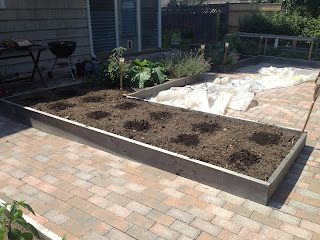Ninety Days Until Frost
I know, I know. How can I be thinking about frost on a day, during a week like this? It's so hot that the ice rink down the street can barely keep it together for skating classes. Still, our average first frost date is October 15, and that's just 90 days from today.
That all seems very far away until you start reading the backs of seed packets. When some of your cabbages take 90 days to mature, and your broccoli is looking at 75 days, it's time to get fall planting plans underway.
If you care about eating once it gets cold and dark, that is.
Our peas have just finished for the season, and over the weekend we pulled out the trellises to make room for some fall crops. Ditto on the garlic, which is harvested and curing in the workshop. That leaves us space to get cracking on our fall plantings, most of which I sowed over the past couple of days:
I realize that empty dirt isn't all that exciting to look at, but that's where the action is. In the long bed in the center of the photo above, you can see our succession plantings of green beans. The oldest (flopping over from having just ben rifled through to harvest) are to the far left, and the youngest are still quite small toward the center. The dark patch of dirt is our last sowing, which has been mulched over with compost to help keep the seeds moist until they germinate. Planting a section every three weeks keeps our crops manageable and should keep us in beans until frost.
There is also a row of parsnips running the entire length of that bed. Many are camouflaged by the beans, but you can see them to the left. In the foot of space in front of those parsnips (created by removing pea trellises), I sowed carrots and radishes for fall. I only did half of the length of the bed; in another couple of weeks I will plant out the remaining bit of the bed with the last carrots for fall and to overwinter.
Also, as the summer goes on and those green beans finish their life cycle, I'll pull them and plant our winter spinach, mache, and kale in the (legume-y, nitrogen-rich) space left behind. That means this whole 4 x 27 foot bed will be full of fall crops that we will cover over with greenhouse tunnels and/or cold frames when the weather turns cold. It will be nice to have a big chunk of our cold-weather eats all in one spot!
A similar set-up will happen along the other line of pea trellising that we pulled out (above). I planted broccoli seeds where the peas were (and we will be fencing this off ASAP — fingers crossed we will finally get to enjoy some broccoli this fall!). In the foreground of this long bed are our leeks, which will remain in the ground under greenhouse tunnels for the whole winter. Farther down the bed toward the garage are our onions, which will be harvested in the next few weeks, leaving space to plant fast-growing winter greens like lettuces, bok choy, turnips, and arugula for the fall. All of these things should survive past the frost under our plastic tunnels. Again, I'm pretty excited about managing to group our fall crops under one big cover, which is easier to manage than having lots of little patches spread throughout the garden.
Finally, I amended the bed where the garlic had been with lots of compost (our own — we're inching closer to having all we need from our own piles instead of importing it from the city yard) and sowed our fall cabbages. You can see the darker compost spots I used as mulch over the seeds, which will hold in moisture and show me exactly where to water until they germinate.
I know that cold temperatures and long nights seem almost impossible to imagine right now, but northern gardeners need to have a plan in place if they want to eat throughout the long, New England winters. We've discovered that it's not an impossible task, but definitely a challenge of time- and space-management.






Comments
Post a Comment